Although the Great Recession ended nearly eight years ago, wages have not taken off as in previous recoveries. The sluggish growth in wage rates has sparked calls at the federal, state, and local levels to raise minimum wages.
But such top-down, one-size-fits-all government mandates have a sad history of producing unintended consequences—lost jobs, fewer work hours, and higher consumer costs.
History now seems poised to repeat itself in Flagstaff, Arizona, where the new year ushered in an $11 per hour minimum wage. That’s $1 above the state minimum and $3.75 above the federal standard.
To coincide with the Jan. 1 increase, the Flagstaff Chamber of Commerce polled 200 local businesses of varying sizes and industries to gather information on what effect the increase would have. The results affirm mandatory wage hikes remain an ineffective and costly way to help the poor.
The poll responses show that even the seemingly minor $1 increase has significant ramifications. More than three-quarters (77 percent) of the companies expect it to have an effect on their businesses. More than half (53 percent) said it would force them to make undesirable adjustments, such as raising prices, decreasing work hours, or laying off employees, just to stay afloat.
Though the $11 minimum already seems to be taking its toll, significantly greater damage is on the horizon. Flagstaff’s minimum wage is slated to keep moving up until it hits $15.50 in 2022.
In Arizona, the $15 minimum is predicted to result in more than 200,000 lost jobs—almost all among the state’s lowest-skilled workers.
Raising the minimum wage also alters employment opportunities far into the future. It encourages industries that rely heavily on low-wage labor to seek more affordable technological upgrades, such as the self-serve kiosks now seen in many fast food restaurants.
Some of these jobs would be lost to new technology in any event. But a forced wage bump accelerates the switch. In other cases, businesses simply go with fewer workers. Unless remaining workers boost their productivity, those businesses will deliver worse service and less output—a recipe for slowly going out of business. […]
Want more BFT? Leave us a voicemail on our page or follow us on Twitter @BFT_Podcast and Facebook @BluntForceTruthPodcast. We want to hear from you! There’s no better place to get the #BluntForceTruth.






![Trey Gowdy Goes on Fox News, Drops a Bomb About Law Preventing Next Mass Killing [VIDEO] Trey Gowdy Goes on Fox News, Drops a Bomb About Law Preventing Next Mass Killing [VIDEO]](https://bluntforcetruth.com/wp-content/uploads/2018/02/va0Cm29l-200x200.jpg)
